- Author Arianna Cook [email protected].
- Public 2024-01-12 17:55.
- Last modified 2025-06-01 07:38.
Description of the rhubarb plant, agricultural planting and care techniques on the site, how to reproduce, diseases and pests during cultivation, and the fight against them, facts to note and use, types and varieties.
Rhubarb (Rheum) belongs to the genus of representatives of the flora that are part of the Buckwheat family (Polygonaceae), which is often called Buckwheat or Sporyshev. It includes plants that have in their embryos a pair of oppositely located cotyledons. The number of species that make up the genus reaches twenty units. They are distributed in the territory stretching from Asia to the Siberian regions and the Himalayan mountains, reaching Israel. Rhubarb is not uncommon in the gardens and gardens of European countries. However, China is still considered to be his homeland.
| Family name | Buckwheat or Knotweed |
| Growing period | Perennial |
| Vegetation form | Herbaceous |
| Breeds | Seeds or vegetatively |
| Open ground transplant terms | End of April - beginning of May or in the first half of September |
| Landing rules | At a distance of 1 m from each other, the depth of the pit is 0.5 m |
| Priming | Moisture-intensive, preferably loamy |
| Soil acidity values, pH | 6, 5-7 (neutral) or alkaline (above 7, 5) |
| Illumination level | Anyone fits |
| Humidity level | Moisture-loving |
| Special care rules | Regular fertilization |
| Height options | About 1-2.5 m |
| Flowering period | All summer |
| Type of inflorescences or flowers | Panicle |
| Color of flowers | White, yellow, or greenish, sometimes pinkish or blood red |
| Fruit type | Triangular nut |
| The timing of fruit ripening | July |
| Application | For cooking and medicinal purposes |
| USDA zone | 4-8 |
The origin of the name of the genus rhubarb has several versions. So if we talk about the term in Latin, then it goes back to the ancient Greek word "reo ae f", which translates as "flow". This is because in nature the plant prefers the banks of rivers and streams. In the Middle Ages, the so-called "double" name of rhubarb arose because it was supplied from overseas and it turned out "rha barbara", that is, "barbarian root" or "foreign rhubarb", which was later transformed into the modern "rhubarb". On Russian lands, since the representative of the flora was supplied in other ways, its name is closer to the word in Turkish or Persian "ravent".
All varieties of rhubarb are perennials characterized by a herbaceous form of growth. Their rhizome is thickened and woody, with branches. By the third year of its growth, the radius of distribution of the root system can be almost 100 cm, while the depth of occurrence is about half a meter. The color of the roots takes on a reddish or brown tint. The height of the stems of rhubarb usually reaches a meter mark, but in rare cases they are 2.5 m. The stems are 2-5 cm in diameter. The shoots growing above the ground are annuals, they are straight, slightly branched, with thickenings. Basically, they have a cavity inside, the surface in rare cases is distinguished by the presence of weakly pronounced grooves. The color of the stems of rhubarb is green, but there is a pattern of spots and stripes of a reddish hue.
Rhubarb in one bush can have up to 30 leaves. The foliage in the root zone is fleshy, large in size, attached to the stems by means of elongated petioles (approximately 30-70 cm long). The leaf plates are solid, characterized by a palmate-lobed shape, or they may be serrated. It often happens that rhubarb has a wavy edge on the foliage. The petioles are cylindrical or multi-faceted. At their base there is a large socket. The leaves on the stems are smaller. The color of the leaf plates of a rich green color, while on the surface at the base, veins of a whitish color are visible.
During flowering, the stem of rhubarb is crowned with a large paniculate inflorescence, or it may be in the leaf axils. The inflorescence is composed of white, yellow or greenish flowers, but in rare cases, buds with pink or blood-red petals can bloom. The length of the inflorescence reaches 50 cm. Flowers are often bisexual, or if they are underdeveloped, they become unisexual. Perianth in flowers is simple, composed of three pairs of leaves. Such leaves are equal in size or those that grow on the outside are slightly smaller than the inside ones. After pollination takes place, the perianth begins to fade.
In rhubarb flowers, you can count 9 stamens arranged in two circles, while the circle that is outside is double. The flower contains: a single pistil with an upper unilocular ovary with three edges, three columns and stigmas characterized by the form of a horseshoe or capitate-reniform. The flowering process lasts all summer, but the plant begins to bloom only after reaching the age of three.
Important
If the bush has begun to bloom, then this is a signal that rhubarb needs rejuvenation.
There is information that foliage should not be eaten after the plant has begun to bloom, this is not entirely true. Flowering does not in any way affect the substances that are in the foliage. However, it is recommended to eat only young rhubarb leaves, as they are filled with healthy malic and citric acids. Oxalic acid collects in old leaf plates. This is because this substance is used by rhubarb for growth, and since the old leaves have already stopped growing, oxalic acid begins to actively accumulate in them, and it has a very negative effect on the state of the human body and can cause poisoning.
Rhubarb has a nut-like fruit with three sides, characterized by wide or narrow wings. The length of such nuts is 7-9 cm. The seed inside the fruit is protein, the embryo is in the central part. Ripening occurs in the month of July.
Rhubarb is not capricious in its care, but it contains a large amount of various vitamins, mineral salts, as well as proteins and carbohydrates. For a long time it has been used in cooking and folk medicine, and with a little effort you can grow such a useful plant on your site.
Agrotechnics of planting and caring for rhubarb outdoors
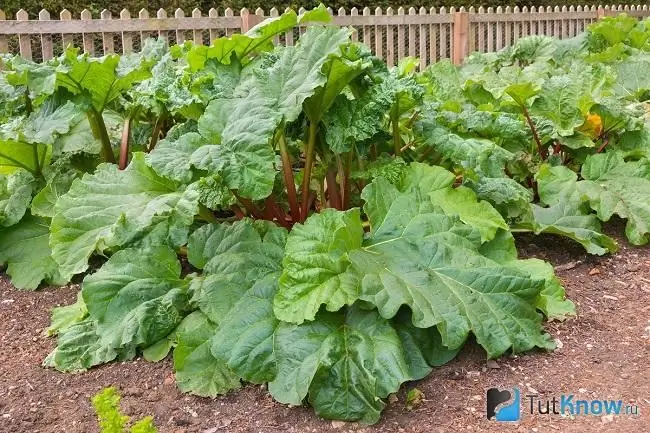
- Landing place seedlings or a cut of rhubarb should be selected carefully, since it can not be changed for 10-15 years, but since the yield will gradually decrease, then transplantation or rejuvenation will be needed. Rhubarb is frost-resistant and can tolerate even a significant drop in temperature (down to -40 frost) without damage. Such bushes are planted both in the shade of tall trees and in a sunny location. In the latter case, rapid growth and high yield are noted.
- Rhubarb soil it is recommended to use fertile, better loamy, capable of retaining moisture for a long time. This is due to the fact that the plant has a powerful root system, long and large leaves and is able to deplete the substrate around it. Before planting, it is recommended to carry out a deep digging of the soil in the selected area, add both humus and organic matter to it, as well as fertilizers. If the soil is acidic, then it is limed by mixing in ash, dolomite flour or slaked lime.
- Planting rhubarb parcels held from late April or early May or in the first two weeks of September. This is necessary so that the seedlings have time to root normally before the onset of frost. It is recommended to dig holes with a diameter and depth of at least 0.5 m. The distance at which they are placed should be at least one meter. Before planting, preparation is carried out - in each of the holes you need to add 5-7 kg of humus or well-rotted compost, as well as about 80 grams of wood ash and 30-35 grams of lime. It is recommended to add 40-45 grams of a vegetable mixture of fertilizers. All components are mixed well, combined with the soil and after that the hole is watered abundantly. The planting of rhubarb cuttings should be carried out to a depth so that the thickness of the soil above the apical buds does not exceed 1-2 cm. After planting the rhizomes, the substrate must be carefully squeezed, while forming a small groove at the same time. After that, watering is performed, and then the near-stem circle is sprinkled with dry soil or humus - mulching is carried out. The last operation will protect against rapid drying out of the soil and will not allow weeds to quickly germinate. Only 4-8 rhubarb bushes will ensure that the family will be provided with this nutritious plant for the whole year.
- Watering when cultivating rhubarb, it is performed 3-4 times during the growing season. For each 1m2 of planting, 30-40 liters of water are used. Such moistening of the soil will help to reduce the content of oxalic acid in foliage and petioles.
- Fertilizers when caring for rhubarb, it must be used due to the fact that there is a rapid depletion of the soil. Top dressing is applied regularly. It is best to use organics and ammonia preparations. As the first, they use a solution from a mullein in a ratio of 1: 6, diluted in water or diluted with bird droppings at a concentration of 1:10. Mineral preparations can be ammonium nitrate or urea. Fertilizers in a 10 liter bucket of water are diluted with 20-30 grams. For every 4-5 plants, there should be 10 liters of solution. If the growth of rhubarb bushes is poor, then after 30 days it is recommended to fertilize again. The solution is prepared in a 10 liter bucket of water, using 50-60 grams of garden mixture, which should be enough for 5 copies. After the autumn dressing of dead foliage, it is necessary to add a composition of the garden mixture and wood ash, which must be embedded in the soil. The first component is taken 70-80 grams per 1 m2, the second - 60-80 grams for the same area. With the arrival of early spring, after checking the rhubarb bushes (they are alive or need a new planting), a layer of manure should be spread over the surface of the site, which covered the plants. Then add ammonium nitrate (30 grams) and calcium chloride (about 20 grams) for each 1m2, embedding them in the ground. Such manipulations are recommended to be performed annually in the spring. Fertilizers containing phosphorus should not be used in the spring-summer period, but only with the arrival of September, otherwise it will lead to an acceleration of flowering and a decrease in the yield of petioles.
- General advice on care. It is necessary to carry out such operations for the planted rhubarb bushes immediately. They will include loosening row spacings and weeding from weeds. This is necessary throughout the summer months 3-4 times after watering has been completed, liquid fertilizing has been applied, or it has rained. With the arrival of autumn, all leaves and petioles must be removed from the site. When early spring comes, you need to check how the specimens planted last year have taken root, and if they died, then place new ones in their place. If the rhubarb bushes are covered with a film at the beginning of April, then their growth will increase significantly. At the same time, the yield will increase by 30-40%. The petioles will ripen 14-20 days ahead of schedule. With greenhouse cultivation, it is possible to obtain petioles in winter.
- Wintering. When persistent cold weather sets in in winter, it is recommended to shelter the plantings of rhubarb. To do this, use a layer of humus, manure or peat chips. Each plant takes 5-7 kg. This will protect the roots from freezing, and with the arrival of spring, it will enrich the substrate with organic matter.
- Harvesting. By mid-May, in the second year, you can begin to collect rhubarb stalks. Usually, 2-3 pieces of them are broken off from each bush, with a length of about 30-50 cm. In the third year, up to 20 petioles are collected from each specimen throughout the summer months, with intervals of 10 days. The end of harvesting is in mid-July. You can store all harvested crops in a cool place (basement or refrigerator).
Read also tips for growing muhlenbeckia.
How to do rhubarb breeding?
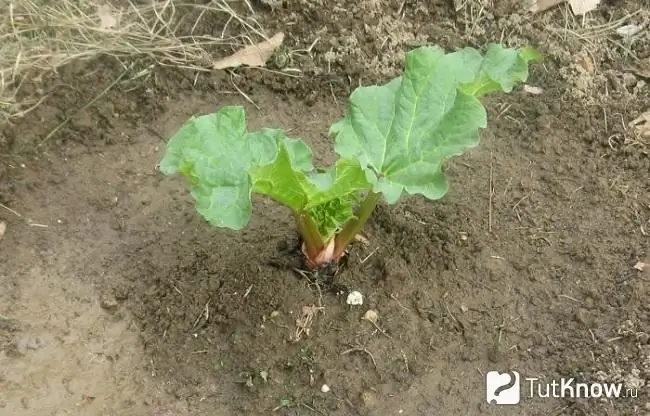
Most often, this representative of the flora can be propagated by seeds or using the vegetative method (parts of the rhizome - delenki).
- Propagation of rhubarb using seeds. To use the seed method, you must first grow seedlings. At the same time, it is noted that approximately 75% of the emerged seedlings will lose their varietal characteristics, and they will not be as productive. Such plants will be able to get a harvest only in the third year, from the moment of sowing. If a decision is made to deal with seedlings, then it is recommended to form a school (seedling bed), where the seed is sown. Freshly harvested rhubarb seeds are used. Sowing is carried out as in the fall, even on frozen soil or in spring. In the latter case, a preliminary monthly stratification is required - the seeds are kept for 30 days on the lower shelf of the refrigerator at a temperature of 0-5 degrees Celsius. Rhubarb seeds are planted to a depth of no more than 2-3 cm. Usually, after 15-20 days, the first sprouts of rhubarb can be seen. They should be thinned out. When 1-2 years have passed from the moment of planting, then transplantation to a permanent place in the garden is necessary. Such manipulation is carried out in early spring or early September.
- Propagation of rhubarb by parts of rhizomes. This method is better because the harvest will be able to be harvested in the second year of cultivation. To do this, it is necessary in the spring or at the beginning of September to select a completely healthy and well-developed plant that has reached 3-4 years of age. It is removed from the ground, and the rhizome is divided into parts with a sharpened knife or shovel. Each of the divisions should have 1-2 sufficiently developed buds and a pair of thickened root processes. All sections must be immediately sprinkled with crushed charcoal for disinfection. After that, the rhubarb cuttings are placed in the shade to dry. This will save the seedlings in the future from decay after planting in the ground. Landing is carried out according to the above rules.
Read also about the rules for self-breeding homaloclodium.
Diseases and pests when growing rhubarb, fighting them
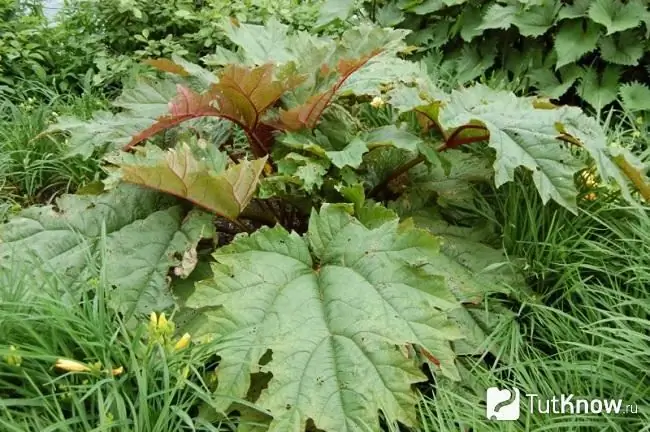
In many sources there is information that this representative of the flora is not affected by both diseases and pest attacks. But due to its cultural cultivation for quite a long time, rhubarb still has not passed such troubles, from which almost all garden plantings suffer.
Diseases of viral origin, which are commonly called mosaic, have become a frequent problem. Usually, aphids (about 70 different types of pests) act as carriers. Here are the main symptoms identified by five different types of virus:
- young foliage acquires curvature and becomes wrinkled;
- alternating dark or light green spots appear on the surface of rhubarb leaf plates;
- flowering and fruiting does not occur.
There is no cure for viral diseases, and all affected specimens must be destroyed (burned). In order to prevent such diseases for prophylactic purposes, it is recommended to deal with the carrier - aphids in a timely manner, using insecticidal preparations (for example, Aktaru or Karbofos). If you do not want to use chemistry, then folk remedies will help here - the use of infusion of ash or tobacco.
The next disease that affects rhubarb is cercomorosis (Cercospora rhapontici Tehon et Daniels), which is manifested by the appearance of spotting of a yellow-brown hue on the leaf surface. All affected leaves are removed by the fungus, and for prevention, moisture stagnation should be avoided, the soil should be loosened, the beds are treated with potassium-phosphorus fertilizers before planting.
For rhubarb, bacterial rot (gray and white), clearly visible due to spots or bloom of a whitish or gray tint, cause problems. To avoid such diseases, it is recommended to spray with fungicidal agents, such as Fundazol, but then foliage should not be used for food. But if you take folk methods, such as solutions, from ash or coal, then you can stop the disease and not subject the leaves to chemical treatment.
Also, fungal diseases affecting rhubarb can be rust or powdery mildew, which mainly appear in the southern growing regions with high humidity. It is also possible to use fungicidal agents here, but if you still want to use rhubarb foliage and stalks for food, then folk remedies will help: a solution based on ash, potassium permanganate, brilliant green or even whey (milk).
A pest that occurs on rhubarb plantings can be not only aphids, but also a rhubarb bug (Syromaster marginatus) and a potato scoop. Young specimens in particular fall under the "blow". In order not to apply insecticides, decoctions of plants such as wormwood and tansy are prepared and then spraying is performed.
Facts to note about rhubarb and its uses
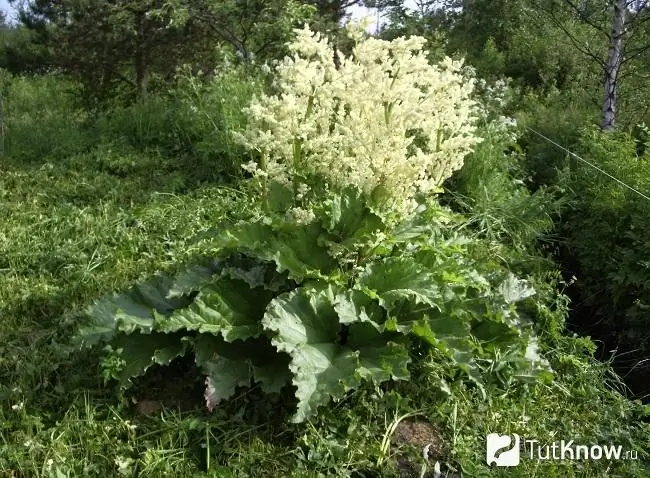
For a long time in our regions they knew about this plant, which often acted as a weed growing near fences. But in the years of famine, when everything was eaten, the people tasted the foliage and stems of rhubarb, which also had a healing effect.
In cooking, it is customary to use young leaves that do not yet contain oxalic acid and long fleshy petioles (the length of which is 20-70 cm). The petioles contain not only citric and malic acid, as in foliage, but also a large amount of carbohydrates and vitamins (such as C, B and PP), as well as carotene, phosphorus, magnesium, potassium salts and pectin substances. People noticed that when using these parts of rhubarb, the work of the digestive tract improved, and food was better absorbed.
Rhubarb was also used for medicinal purposes as a laxative, and it was also prescribed to patients suffering from anemia and tuberculosis. You can also eat small amounts of rhubarb for people with low acidity. Folk healers know about the plant as a choleretic, moreover, capable of helping in the work of the heart or lungs. For medicinal purposes, it is customary to prepare tinctures, syrups or extracts from rhubarb.
Although rhizomes are not used in food, drugs can be made from them. This is because the root system is rich in glycosides, which have a double effect on the body: on the one hand, an astringent (in a low dosage), on the other, a laxative in high concentration. This is what doctors prescribe for constipation, intestinal atony, or gas. The effect of such a powder, infusion or just rhubarb juice is expected after 8-10 hours. However, elderly patients, especially those suffering from hemorrhoids, are prohibited from taking such funds.
Important
Long-term use of rhubarb-based drugs is addictive, and its effectiveness is steadily reduced.
However, with all the positive effects in the use of this representative of the flora, it is important to note that old leaves can contain a large amount of oxalic acid and only 2-4 grams cause serious poisoning (a special danger for children). Since rhubarb contains a large amount of acids that can contribute to the formation of stones in the bladder or gall bladder or kidneys, people with gallstone or urolithiasis should not use it. Also, you should not overuse dishes with the addition of rhubarb for those who suffer from high acidity or pancreatitis. Large doses of this plant are contraindicated in the following categories of patients:
- with bleeding of various origins;
- with acute appendicitis;
- with diabetes mellitus and cholecystitis;
- the presence of rheumatism or gout;
- any period of pregnancy.
Description of species and varieties of rhubarb
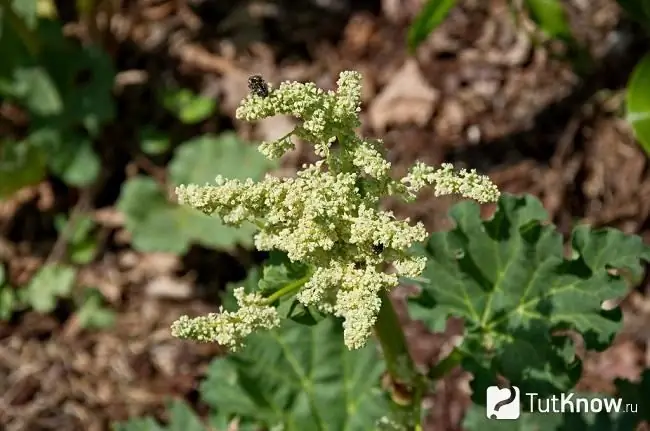
Rhubarb (Rheum officinale)
The specific name directly indicates the scope of use of this plant. The homeland is China, but it is cultivated throughout the entire former USSR, as well as European countries as a medicinal flora. Perennial herbaceous growth, characterized by strong branching of the rhizome. The height of the stems reaches 2 m. These stems are juicy, thick and fragile. They taste sour. The stems grow straight, on their surface there are small grooves and small villi, there is a cavity inside.
The foliage is large, the surface is rough. The leaves are juicy, have a palmate-lobed shape. In the root zone, they are attached with long petioles, the stem ones have sockets. The blades of the leaf plates are poorly expressed, there are 3-8 of them. The edge has triangular teeth, there are 3-5 units for each blade. When flowering, a large paniculate inflorescence is formed. It has a leafy appearance and wide branching, a spread-out structure. Its flowers are white, yellowish or green, depending on the variety. The fruits are represented by nuts with three sides.
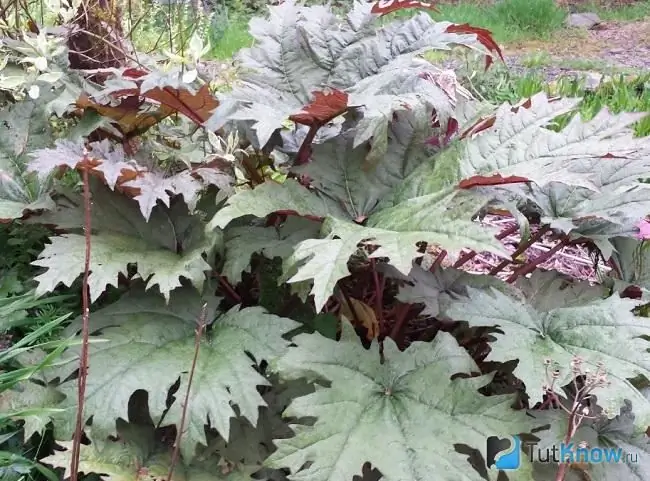
Finger rhubarb (Rheum palmatum)
… Moisture-loving perennial with herbaceous growth. The native area of growth is the central Chinese regions. It can be grown both in Siberia and in the Moscow and Voronezh regions. It has a straight stem with little branching. Its height is within 1-3 m, its diameter is 2-5 cm. Stems are hollow, color is green with spots and stripes of a reddish hue. The length of the short and thick rhizome is 3-6 cm. It is characterized by multi-headedness and a small number of large lateral adventitious roots. Such root processes are fleshy. All rhizomes have a dark brown color, and on the fold are painted in a bright yellow tone.
The length of leaves in the root zone reaches 1 m and more. Their size is large, such leaves have elongated petioles. The leaf plates are composed of 5-7 blades. The length of the semi-cylindrical petioles can approach 30 cm. Their color is reddish. The outlines of the leaves are broadly ovate. There is pubescence on the upper side with short hairs, on the back they are longer. Leaves on stems are smaller, brown dry trumpets are present at the base.
During summer flowering (in June), a panicle appears, formed by a large number of flowers. The length of the inflorescence is 0.5 m. Flowers in the inflorescence are bisexual, with whitish-cream, pinkish or red petals. The fruit is a nutlet, colored red-brown. Its length reaches 7-10 cm. Fruits ripen in the middle of summer.

Rhubarb cultivated, garden (Rheum x cultorum Thorsrud)
It is a rather old complex hybrid plant, the origin of which is unknown, but there are opinions that the species of Black Sea rhubarb (Rheum raponticum) took part in the selection. Perennial, with powerful herbaceous outlines, reaching a height of 1.5 m, over the years it is able to form a dense rounded bush. The stems grow straight, differ in thickness and branching. There are grooves on their surface, often the color is reddish. Leafy stems.
The length of the leaf plates varies from 40 to 60 cm. The outlines of the leaves are ovoid or oblong-broadly ovate. Their apex is obtuse, the base is heart-shaped. Waviness is present on the edge, 5-7 veins are visible at the base. The leaves are bare from above, their reverse side along the veins has a hairy pubescence. The petioles are 30-40 cm long. They are powerful and reddish in color.
When flowering, panicle inflorescences are composed of whitish-pink or yellowish-whitish, in rare cases, reddish small flowers. There are a lot of them in the inflorescence. The dense panicle has a narrow outline and reaches 20 cm in length. The fruits are triangular nuts. They have membranous wings with a deep heart shape and a red tint. Flowering is observed throughout June-July. The plant can tolerate frosts down to -40 degrees. There are a large number of varieties, among which the following are popular:
- Zaryanka characterized by early ripeness and petiole length of about 45 cm. The leaf rosette is spreading. Aging amicable within a month. On the petioles there is a pattern of cherry spots. The taste of the pinkish-green petiole pulp is sweet and sour.
- Stubborn is also early maturing. Its petioles are measured at 0.55 m. Ripening takes about 45 days. By weight, the petioles can be 180 grams. The petioles are colored in a light greenish tint, gradually turning into purple at the base.
- Victoria - a recognized old variety, characterized by a high yield. The length of the petioles can reach 0.7 m. They have excellent taste. At first, the petioles are distinguished by a dark red hue, gradually changing to green and acquiring a dark tone at the base. The mass of petioles on average ranges from 200-300 grams. Since the formation of peduncles is rapidly occurring in the bush, it requires their prompt removal. This should be done from the end of spring, preventing their growth.
The following varieties can also be noted - Altai Dawns (petioles weight 80-120 grams), Large petioles (petioles reach 70 cm in length with a diameter of 3 cm), Moskovsky (with 0.55 m petioles) and others.
Related article: Tips for planting and caring for pyrethrum outdoors
Video about growing and using rhubarb:









